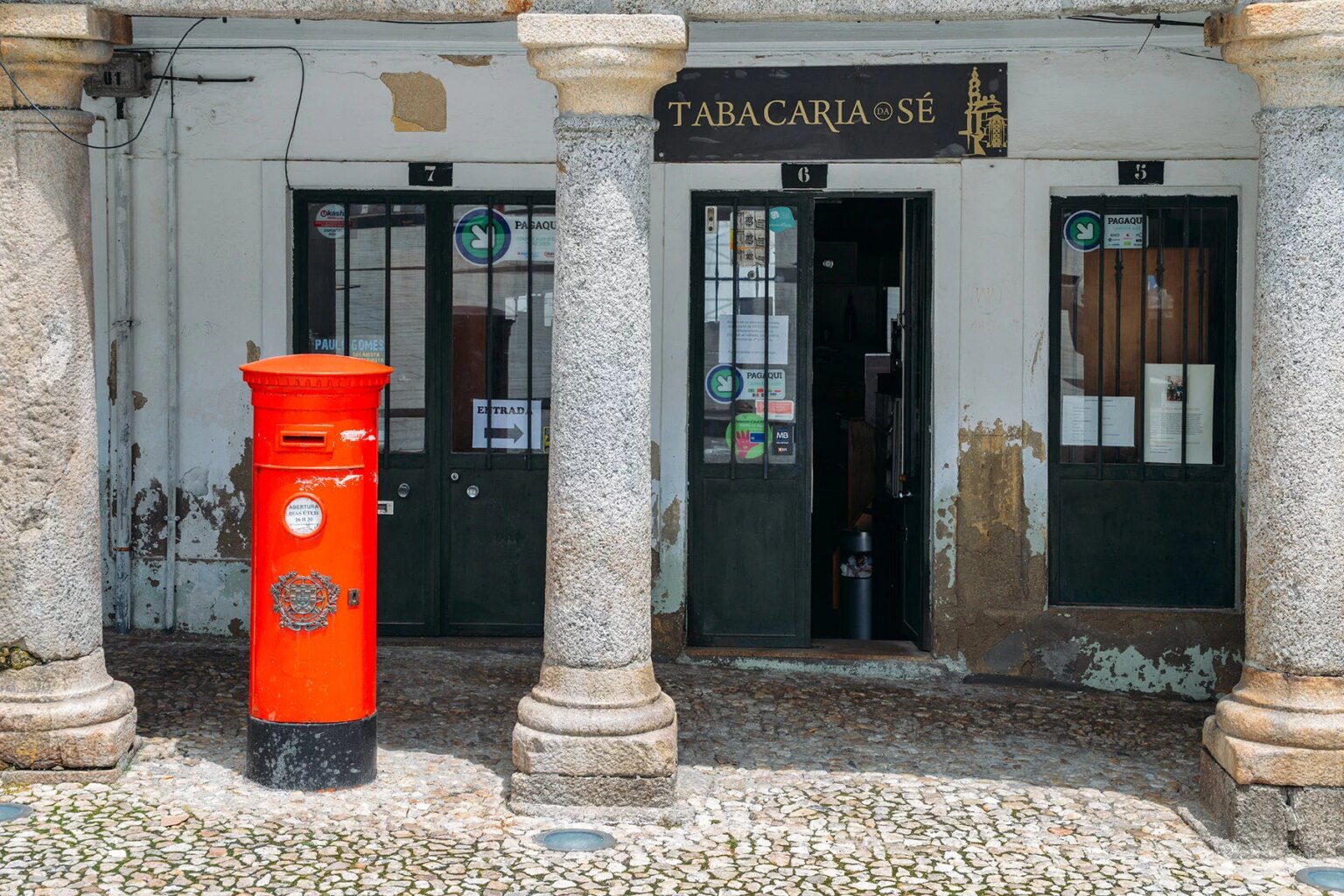Portugal created its national postal service in 1520 when King Manuel I launched the Correio Público. Since then, it has undergone several organizational shifts and name changes. However, nowadays, it is widely known as CTT or Correios de Portugal.
Whether you’re sending a small postcard from your travels in Portugal or you’re moving there with all your belongings, it’s important to understand how the local postal system works. Moreover, with so many services on offer these days, it can be tricky trying to figure out which one to use. So, to help you navigate the Portuguese postal service with ease, this article outlines the following information:
- The Portuguese postal service: CTT
- Sending and receiving mail in Portugal
- Sending and receiving parcels and large items
- Post offices and post boxes in Portugal
- Overseas shipping in Portugal
- Business mail in Portugal
- Mail forwarding services
- Additional postal services
- Mailing tips in Portugal
- Useful resources
The Portuguese postal service: CTT
Correios de Portugal (CTT) is the main centralized postal service in Portugal. For nearly 500 years, it was a state-run company. However, in 2011, an agreement was signed with the European troika to privatize it. The deal was implemented in two stages and completed three years later, in 2014. Currently, the biggest stock shares (around 13%) belong to the Manuel Champalimaud group, a Portuguese holding company.

Over the years, the CTT has grown to offer a wide range of services, including national and international mailing, postal boxes, banking, and insurance. If you own a house in Portugal, you can also head to the post office to pay your utility bills, car toll fees (portagens), and even buy concert tickets.
However, while CTT remains Portugal’s top mailing provider, other companies also offer shipping services. Some of the biggest names include DHL, FedEx, and UPS.
Sending and receiving mail in Portugal
There are several options to consider when sending and receiving mail in Portugal. If you are sending a letter, the maximum weight allowed is 2kg. Anything heavier than that will be classed as a small parcel.
Below are the most common types of post services in Portugal and their average delivery times:
- Standard mail (correio normal): Portugal (three working days), Europe (five working days), rest of the world (seven working days)
- Priority mail sustainable (correio verde): No weight limit, but must use dedicated packages. Delivery time: Portugal (one working day), Europe (five working days), rest of the world (seven working days).
- Priority mail (correio azul): Portugal (one working day), Europe (three working days), rest of the world (five working days)
- Registered mail (correio registado): This includes proof of posting, tracking number, and delivery confirmation, which requires the recipient’s signature. Delivery time: Portugal (one working day), Europe (three working days), rest of the world (five working days).
- Express mail (correio expresso or CTT Express): This is usually the fastest service, with same-day delivery within the Iberian Peninsula and one to five working days for other international destinations.
Portuguese postage rates
As with other national postal services across Europe, CTT has a mixed reputation. Therefore, if you need to send anything of high value to another European country, and want to make sure that it arrives safely and on time, you might prefer to use a global courier company, such as DHL or UPS. Notably, you can also use the same international services to send parcels to Portugal.
Generally speaking, prices of postal services in Portugal are typically below EU averages, and range from €4.50 to €30. You can also calculate Portuguese postage rates by using the CTT’s price calculator.
Where to buy stamps and envelopes
You can buy stamps (selos) in Portugal at any CTT post office or newsagent. Some small shops, such as lottery shops (Casa da Sorte), also offer basic postal services. Alternatively, you can buy Portuguese stamps online directly from the CTT.
It is important to be aware that mail and parcels sent via the Portuguese postal service must be written in pen or printed on a white label. Envelopes are also available at the post office and most stationery shops (papelarias). Once you have a stamp and the recipient’s address, you can drop off your letter at the nearest post office or post box.
Tracking and delivery
If you want to include tracking, make sure to let the post office staff know in advance. You can then check the location of your parcel on the CTT’s website. If the recipient isn’t in on the day of the delivery, the postman will leave a notification in the mailbox.
The deadline for pick-up varies with the service but will usually be under ‘data de aviso’ (notice date). The recipient can then pick up the letter at their local post office or arrange for redelivery. Usually, it is necessary to show a form of identification to collect it, such as a residence permit or passport.
Postcodes in Portugal
Naturally, you will need to know the Portuguese postal code (código postal) when sending mail within or to Portugal. This consists of seven digits that are separated by a hyphen. The first two digits represent one of the country’s nine postal regions, while the next two stand for postal distribution centers. The last three numbers after the hyphen are for the home addresses and building numbers.

You should include the postcode after the street address and before the city name, like so:
Rua Nova da Piedade
1200-296 Lisboa
Portugal’s post also offers a postal code-finding service to help consumers make sure their parcels arrive at the correct location.
Sending and receiving parcels and large items
If you are planning to send a large parcel to someone living in Portugal or abroad, you can still use CTT. Below is a list of the services available and the estimated delivery time:
- Standard parcels (encomenda postal): For packages up to 10kg within Portugal or 30kg internationally. Delivery time: Portugal (three working days), Europe (five working days), rest of the world (seven working days).
- Express parcels (encomenda expresso): For packages up to 30kg. Delivery time varies between 24 hours for domestic destinations and one to five working days for the rest of the world.
- CTT Now: For packages up to 30kg. Same-day delivery in select locations across Portugal.
To post a parcel, you must fill out a consignment note (guia de transporte), which is available online or directly at the post office. Of course, prices will vary according to the weight, the destination of the parcel, and additional services such as proof of delivery. For domestic deliveries, the fee starts at around €8.50, while international deliveries cost at least €30.
If the recipient isn’t home to receive the package, CTT will keep it in the post office for up to 10 working days (five for express parcels). After this, the package will be returned to the sender. However, if the sender doesn’t accept it, the package will be considered abandoned. In the event of a lost or damaged package, you should inform the delivery person and contact customer service as soon as possible.
CTT isn’t the only courier that deals with parcel delivery in Portugal. Other companies that also provide this service include:
- DHL
- FedEx
- GLS
- SEUR
- UPS
Post offices and post boxes in Portugal
There are more than 500 post offices in Portugal and 2,000 delivery points where you can drop off a package. The company’s red logo features a figure riding a horse and blowing a horn. You can easily spot the nearest post office or delivery point by searching for this sign. However, if you are having trouble finding one in your area, you can always consult the CTT’s post office search. In some cities, you will also find post boxes. Notably, red boxes are for ordinary mail, while blue ones cover airmail or priority mail.

Portuguese post offices are generally open from 9:00 to 18:00 (Monday to Friday) with some branches closing at lunchtime. A few are open on Saturdays, with shorter opening hours, such as 9:00 to 12:30. Therefore, it’s a good idea to check the schedule online before heading out.
The last postal collection time (hora de recolha) can vary between 11:30 and 21:00. However, if you can’t make it to the post office or don’t want to wait around all day for a delivery, you can always use the Cacifos Locky. This is a network of lockers spread across the country where you can drop off and pick up packages at any time. That said, this option isn’t available for parcels from outside the EU.
Overseas shipping in Portugal
There are several ways to send items overseas from Portugal. You can either head to the post office directly or schedule a pick-up with your chosen courier. CTT offers a variety of international mailing services, including express delivery. The cost will vary according to the destination and the service you choose. Other alternatives include DHL, FedEx, and UPS.
When sending a parcel, you must include a consignment note (guia de transporte) and a customs declaration (declaração para a alfândega) for countries outside the EU. In most cases, you can access these forms online. Additionally, if you are sending any type of goods, you will need to declare the value of these items. You can find a list of regulations for international shipping on the CTT website (in Portuguese).
Depending on the destination, there may be import or export charges that the sender or receiver needs to cover. These are imposed by the national customs authorities and are usually based on the value and type of goods. The Universal Postal Union has provided a list of prohibited items for each country which is useful to know.
If you are relocating to Portugal and want to ship your belongings, such as furniture or a car, there are several alternatives. You can hire an international relocation company or arrange it yourself. Air freight is usually the fastest option, although potentially the most expensive, too. Sea and land freight are also available.
Business mail in Portugal
If you run a business in Portugal, you can use CTT to send items to your customers. Standard mail is ideal for small parcels, but priority mail and registered mail are usually faster. Notably, if you are planning to send packages frequently, you can become a business client. This comes with a few benefits, including exclusive discounts, company pick-up, insurance for items up to €10 per kg, and tracking status.
In some cases, it may be worth investing in a franking machine (máquina de franquiar). This allows businesses to save time and money by letting them pre-pay postage costs and print labels. Other mailing services, such as DHL, also provide business shipping.
Mail forwarding services
If you are in the process of moving house, changing your address for every service can be a pain. However, luckily, the CTT offers a redirection service (reexpedição de correspondências), which allows you to forward mail directly to your new home.
To set this up, customers need to fill out a form with their old and new addresses and include how long they want the mail to be redirected (up to 12 months with renewal available). The form is available online or at the post office. Costs will vary depending on the duration of the redirection and the new destination but tend to start at around €25.80.
If you receive a parcel at your address that is meant for a previous occupant, you can inform the postman or head to the post office to return it to the sender.
Additional postal services
CTT offers additional services such as mail collection (posta restante) and PO boxes (apartados). These are ideal for newcomers or visitors in Portugal who have yet to register with the government or acquire a local address. They can also be used by businesses that need a separate address.
The cost of the posta restante varies depending on the number of objects and package weight but ranges from €1.20 to €3.65. Meanwhile, the apartado fees are based on a six-month (€29) or annual contract (€58).
Customers can apply for either service at any CTT post office. They will need to bring identification and proof of address (such as a utility bill or lease agreement). Payment for the service can be made in advance or through installments over the duration of the contract. However, it is important to note that these boxes are only accessible during post office hours.
Mailing tips in Portugal
Got your package ready to go? Before you head to the post office, here are some tips to help you post with ease:
- Write the return address on the back of the envelope to ensure it does not get lost
- If you need to send cash to someone, use a vale postal. This is a printed document that you can buy at the post office and send to someone to exchange for money at another post office.
- Save time by filling up forms online in advance
- To avoid the long queues at the post office, arrive early or during work hours
- If you have an important document, send it as correio registado (registered mail) to make sure it is delivered to the right person
- If you are sending a package with fragile items, make sure to pad it with packing paper to protect it
Useful resources
- CTT post office search – allows you to find the nearest post office to your home
- CTT tracking – lets you track the location of your package using the CTT reference
- CTT calculator – allows you to calculate the cost of shipping your items with this online simulator
- Your Lisbon Life – an article on How Portugal Addresses Work: 8 essential tips to keep in mind which provides information on street names, apartment floor conventions, and postcodes







